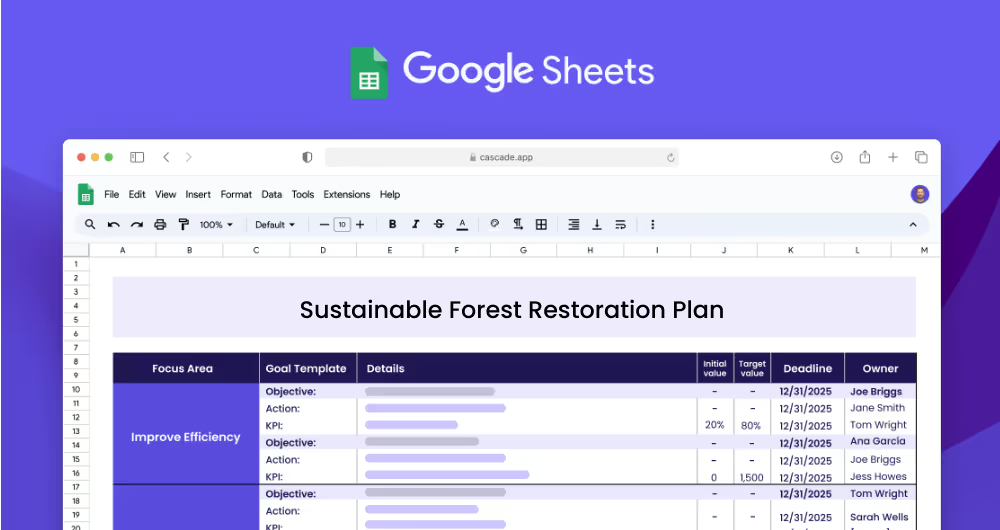A sustainable forest restoration plan is a strategic plan that outlines strategies for reforestation, biodiversity conservation, and sustainable forest management practices for forestry companies and organizations involved in land management. This plan focuses on restoring degraded forests, improving soil health, increasing species diversity, reducing habitat fragmentation, and implementing sustainable harvesting practices. It also aims to reduce illegal logging by increasing patrols and monitoring sites. A sustainable forest restoration plan helps organizations create a framework to ensure long-term success in their efforts to restore and maintain the health of the forests they are responsible for.
Each focus area has its own objectives, projects, and KPIs to ensure that the strategy is comprehensive and effective.
The Sustainable Forest Restoration Plan template is ideal for any forestry company or organization involved in land management who is looking to create a comprehensive plan for restoring and maintaining the health of their forest. This template helps organizations effectively plan and create strategies to ensure long-term success in their forest restoration efforts.
A focus area is a broad category or theme that your strategy will address. Examples of focus areas for a sustainable forest restoration plan include reforestation, biodiversity conservation, and sustainable forest management practices. Each focus area should be further broken down into objectives, actions, measures, and targets. This helps to organize the plan and ensure that the focus area is properly addressed.
Objectives are the goals that are to be achieved under each focus area. These objectives should be specific, measurable, attainable, realistic, and time-bound. Examples of objectives for a sustainable forest restoration plan could include restoring degraded forests, improving soil health, increasing species diversity, reducing habitat fragmentation, and implementing sustainable harvesting practices.
KPIs, or key performance indicators, are measurable targets that are used to track progress towards an objective. KPIs should be specific, measurable, attainable, realistic, and time-bound. Examples of KPIs for a sustainable forest restoration plan could include increasing the number of trees planted per year, reducing soil erosion, increasing the number of species reintroduced, and increasing the area of wildlife corridors.
Projects are the specific actions that will be undertaken to achieve the KPIs. An example of a project related to Reforestation could be: Launch an initiative to plant trees for employees.
If you’re ready to accelerate your strategic efforts and see faster results, Cascade Strategy Execution Software is your next step. Unlike spreadsheets, Cascade provides a streamlined platform designed to help you plan, execute, and track your strategy effectively. With features like real-time updates, centralized collaboration, and automated reporting, Cascade enables seamless integration of strategy planning and execution. This allows your team to stay aligned and quickly adapt to any strategic changes, ensuring a dynamic and responsive approach to your strategic goals. Sign-up for free or book a demo with one of our strategy experts to enhance your strategy execution today.


